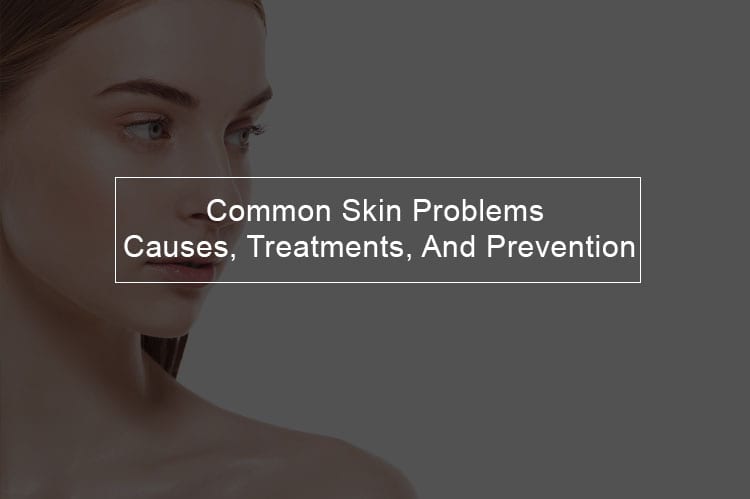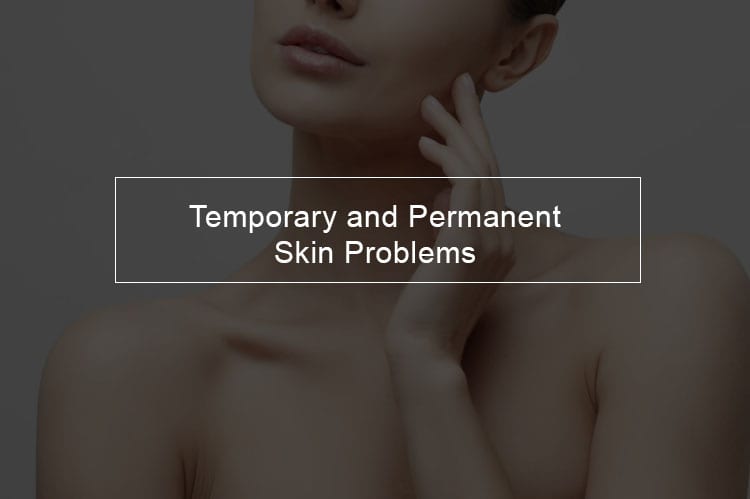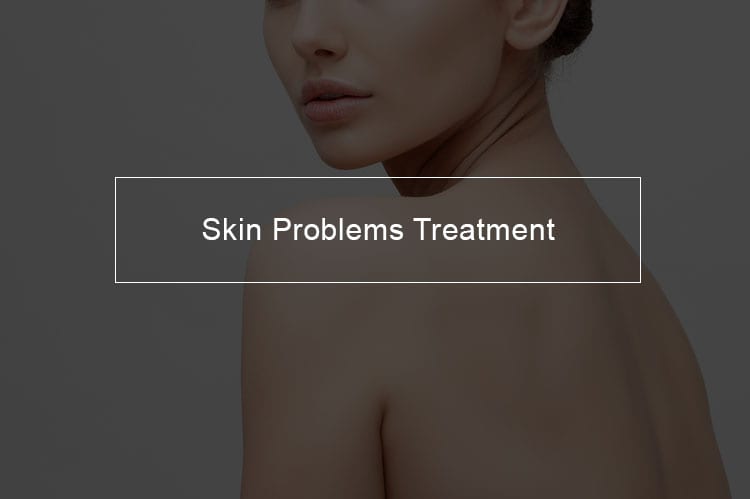
Skin problems are of many different types and appearances. They differ in severity, symptoms, intensity of pain, causes, and how long they affect your skin. Some skin disorder can be life-threatening while others are harmless. On their own, most skin disorders are harmless. However, they might be a sign of a more lethal condition. Always visit a doctor when you notice these abnormalities on your skin before it is too late.
What are the most common skin diseases?
How to identify common skin problems?
Acne
Acne appears on the face, chest, shoulders, back, and neck. Acne comes in the form of pimples, whiteheads, blackheads, or the more painful cysts and nodules. If left untreated, acne will leave a scar or darken the skin at the point it was located.
Blister
This common skin problem is known for its fluid-filled sack. The sack usually has some watery, clear, liquid and can vary in sizes. They can also appear in groups or individually anywhere on the body.
Eczema
These are white or yellow scaly patches on the skin that flake off. The affected areas turn itchy, red, oily or greasy. Eczema also makes the affected skin lose hair.
Cold sore
Cold sores appear on the lips and mouth area. They are red, painful blisters with fluids. Before they begin, there is a burning sensation on the area. Cold sore can be accompanied by low fever, swollen lymph nodes, body aches, and other flu-like symptoms in a mild way.
Contact dermatitis
This is a rash with defined borders that appears hours or days after your skin comes in contact with an allergen. The irritating substances cause the skin to be itchy and scaly and turn it red. There is also the appearance of blisters that ooze, weep, or become crusty.
Hives
Hives are some form of raised welts that appear after coming in contact with an allergen. They are itchy, warm, and red. They are also painful when touched. They can be small and ring-shaped or large with random shape.
Actinic keratosis
Actinic keratosis is a scaly, crusty, thick skin patch. It is usually less than 2 cm. Parts that are usually exposed to the sun are at risk of getting actinic keratosis. These parts include the face, arms, scalp, hands, and neck. Actinic keratosis is usually pink with a gray, tan, or brown base.
Rosacea
This is a chronic skin condition which undergoes stages of fading and relapse. After fading, it can be triggered by alcoholic drinks, spicy foods, Helicobacter pylori (intestinal bacteria), stress, and sunlight.
There are four types; erythematotelangiectatic rosacea (ETR), papulopustular (or acne) rosacea, rhinophyma, and ocular rosacea. Each type has unique symptoms, but the common ones include facial redness, red bumps, skin dryness, facial flushing, and skin sensitivity.
Carbuncle
This is an irritating lump under your skin. It is red and painful and may be accompanied by fatigue, body aches, and fever. They can also cause oozing or skin crustiness.
Latex allergy
This condition requires immediate professional attention, it is a medical emergency. A latex product can cause rashes within minutes to hours of exposure. The rash starts as itchy, red, warm wheals and with repeated exposure to latex turn dry and crusted. Latex particles in the air can lead to sneezing, running nose, cough, watery eyes, and itchiness. Severe cases result in swelling and difficulty in breathing.
Vitiligo
This condition is caused by the autoimmune destruction of skin pigmentation cell leading to the skin losing its natural color. Vitiligo can manifest in different ways. When it takes a focal pattern, your skin will lose its color in some small areas that can merge to form one big area. In a segmental pattern, the discoloration is on one side of the body. Vitiligo is also accompanied by premature graying of the facial hair and the scalp.
Psoriasis
These are silvery, scaly, and well-defined skin patches. Psoriasis shows up on the elbows, knees, lower back and scalp. The patch can be itchy too.
Cellulitis
This condition requires immediate professional attention, it is a medical emergency. Cellulitis is as a result of fungi or bacteria getting into the skin through a cut or a crack. The swollen painful skin is red, hot and tender when touched. It also has ooze that spread very fast. This can get worse if it is infected. Signs of infection include chills, red streakings, and fever.
Measles
The symptoms of measles are sore throat, watery eyes, fever, cough, running nose, and loss of appetite. Within three to five days of its appearance, a red rash spreads to the body from the face. In the mouth, you will notice small red spots with very light blue centers.
Melanoma
This is a very serious form of skin cancer that is common among people with fair skins. The multi-colored, irregular shaped mole will appear anywhere on the body. With time, the mole also grows bigger.
Basal cell carcinoma
These are pale areas of the skin that are raised and firm and resemble a scar. They look like a dome with a sunk center, resembling a crater. Basal cell carcinoma is red or pink with pearly and shiny areas. The wound does not appear to heal, and it bleeds or oozes blood very easily.
Squamous cell carcinoma
This starts as a reddish, scaly patch of the skin that grows into a raised bump that also grows. Squamous cell carcinoma appears in places exposed to ultraviolet (UV) radiation such as the face, back of hands, and ears. The growth oozes or bleeds easily and does not appear to heal.
Chickenpox
These are many red and itchy blisters filled with fluids that appear all over the body. Rash also come with body aches, fever, loss of appetite, and sore throat. Before all the blisters have crusted, chickenpox will remain contagious.
Lupus
This is a disc-shaped rash that is scaly but does not itch or hurt. Lupus is usually accompanied by fever, headaches, painful or swollen joints, and fatigue. The patches appear on the forearms, shoulders, neck, and upper torso. They become worse when exposed to sunlight. There are also red rashes across the cheek and nose that worsen with exposure to the sun.
Wart
Human papillomavirus (HPV) is the cause of this skin condition. They occur individually or in groups and can be found on mucous membranes as well as the skin. The wart can be contagious and passed from one person to another.
Seborrheic eczema
These are white or yellow patches on the skin that are scaly and flake off. The area turns red and becomes itchy, oily, or greasy. The place with the rash also experiences hair loss.
Impetigo
Impetigo is a common skin condition in children and babies. It is characterized by an irritating rash that is found around the chin, mouth, and nose. Impetigo also comes with blisters filled with a fluid that pops with ease forming a crust that is honey-colored.
Ringworm
These are scaly rashes that are circular with raised borders. The center, in the middle of the ring, usually appears healthy and clear with the edges spread out. They are normally very itchy.
Keratosis pilaris
These are scaly rashes that are circular with raised borders. The center, in the middle of the ring, usually appears healthy and clear with the edges spread out. They are normally very itchy.
Melasma
This skin disorder causes the appearance of dark patches on the face, and sometimes on the arms, chest, and neck. This condition is more common in certain groups such as people with darker skin complexion, pregnant women, and people who are frequently exposed to heavy sunlight. There are no other symptoms apart from the skin discoloration, which may disappear within a year or stay permanent.

Temporary skin disorders
Which skin disorders are temporary?
There are many skin conditions that disappear with time. The common ones include contact dermatitis and keratosis pilaris.
Contact dermatitis
This is among the common temporary skin disorders. The cause of this condition is an allergen, chemicals, or other irritants. When the skin comes into direct contact with such substances, it can lead to a reaction that makes it inflamed, red, and itchy. Many cases of contact dermatitis are rather harmless. However, the itching can be an inconvenience. The best way to prevent contact dermatitis is to avoid things that cause the reaction. If you already have it, topical creams can help treat it.
Keratosis pilaris
This minor condition is characterized by tiny, rough bumps on the skin that appear on the thighs, upper arms, or cheeks. The white or red bumps are harmless; they don’t itch or hurt. You don’t have to treat them, but you can use some medical creams to improve the look.
Permanent skin disorders
Which skin disorders are permanent?
There are skin conditions that do not go away. You are either born with this disorder, or it appears later in life and stays. This suggests that these disorders are incurable, which is true. However, there are treatments that are effective enough to cause remissions for extended periods of time. The symptoms will then eventually reappear.
Permanent skin disorders
- psoriasis, which is characterized by itchy, scaly, and dry patches.
- rosacea, which causes tiny, red bumps filled with pus that appears on the face.
- vitiligo, which is characterized by huge, irregular skin patches.
The causes of these conditions are not always clear.
Symptoms of Skin Disorders
What are the symptoms of skin disorders?
Skin disorders have many different symptoms. Some symptoms are very common while others are not. There are symptoms on the skin that are not actually caused by a skin disorder. Blisters, for example, can be caused by using hand tools or by wearing the wrong shoes. Some symptoms may also be a sign of a more dangerous condition, and therefore you should visit a doctor immediately after noticing these symptoms.
The common symptoms in skin disorder are as follows:
- scaly, rough skin
- open sores or lesions
- ulcers
- white or red raised bumps
- dry, cracked skin
- itchy or painful rash
- peeling skin
- discolored skin patches
- loss of pigment
- a mole that changes size or color
- excessive flushing
- warts, fleshy bumps, or other growths on the skin
Skin disorders in Children
A lot of children experience skin conditions; this is very common. These disorders are more or less the same as the one's adult face. They are also more vulnerable to skin disorders that are rare among adults because children come into more contact with germs and other children. There are also skin conditions related to diapers. Many of these skin disorders in children usually disappear with age. There are also instances where the children inherit some skin problems that remain permanent.
The common skin problems in children are as follow:
- diaper rash
- eczema
- chickenpox
- hives
- seborrheic dermatitis
- warts
- acne
- ringworm
- fifth disease
- measles
- allergy rashes
- bacterial or fungal infection rashes
Topical creams, specific drugs, and medicated lotions can be used by doctors to treat skin problems in children.
Causes of skin disorders
What causes skin disorders??
The known causes of the common skin problems are:
- a weak immune system
- germs in the hair follicles and skin pores
- allergens, irritants, or infected people
- parasites, fungus, and other microorganisms on the skin
- many different health conditions and lifestyle
- an illness affecting the kidneys, thyroid, immune system, and other body systems.
There are skin conditions that we still do not know their cause.
Other causes of skin problems
Inflammatory bowel disease and skin problems
This is an intestinal condition that causes inflammation in the digestive system. Inflammatory bowel disease is also known to come with some skin problems. Its medication also has effects on the skin.
Skin problems associated with inflammatory bowel disease include:
- anal fissures
- skin tags
- vitiligo
- stomatitis
- vasculitis
- allergic eczema
Pregnancy and Skin Problems
There are many skin conditions associated with pregnancy. This is because the hormone levels are significantly altered. Some of your regular skin issues may worsen or may change.
Skin problems associated with pregnancy include:
- stretch marks
- eczema
- pemphigoid
- melasma
- pruritic urticarial papules and plaques
Most of these problems usually go away after the baby is born. There are some that may require some attention during the pregnancy.
Diabetes and Skin Problems
Skin problems associated with diabetes are common. In fact, there are skin problems that will only affect you if you have diabetes. You are also more vulnerable to some skin conditions if you have diabetes. The risk of blood circulation issues and infection increases with diabetes.
Skin problems associated with diabetes include:
- diabetic blisters
- acanthosis nigricans
- bacterial infections like styes, folliculitis, and boils
- digital sclerosis
- fungal infections like ringworm, yeast infections, and athlete’s foot
- diabetic dermopathy
Lupus and Skin Problems
Lupus is a chronic disease that affects the organs in the body, the joints, and the skin. The inflammatory disease can damage these parts.
Skin problems associated with lupus include:
- scaly lesions that are thick and red
- lesions on the head and face
- purple, red, or black spots on the toes and fingers
- sunburn-like rashes on the body and face
- sores inside the nose and mouth
- ring-shaped lesions on the parts of the body exposed to the sun
- small red dots on the legs
Stress and Skin Problems
Stress is associated with skin problems. The hormonal imbalance caused by stress can trigger or worsen skin problems.
Skin problems related to stress include:
- acne
- eczema
- vitiligo
- rosacea
- psoriasis
- alopecia areata
- ichthyosis
- seborrheic dermatitis
- hives
The Sun and Skin Problems
One of the most stubborn perpetrators of skin problems is the sun. It causes very many skin conditions that can be very harmless or sometimes very life-threatening. The life-threatening ones are thankfully very rare. The sun can not only cause a skin problem but can also worsen an existing one. This is important to know if you want to treat the condition.
Skin problems related to the sun include:
- sunburn
- wrinkles
- moles
- skin cancer
- photosensitivity
- actinic keratosis
Treating Skin Disorders

How do you treat skin disease?
Most skin disorders can easily be treated. Some of the effective treatments for skin problems include:
- use of antibiotics
- medicated ointments and creams
- laser therapy
- antihistamines
- targeted prescription medication
- vitamins or steroid injections
Some skin problems do not require treatment as they vanish on their own or by avoiding their triggers. Some, however, are stubborn, and medication does not work on them. In the cases of permanent skin conditions, they cannot be cured. However, medication can help by giving longer remission periods. Eventually, the symptoms will return due to a number of reasons such as stress, certain triggers, or illness. There are also periods where the symptoms become severe.
Skin disorders that are cosmetic and temporary can be treated with:
- good hygiene
- medicated makeup
- lifestyles changes such as the type of food
- OTC skin care products
Preventing Skin Disorders
How to prevent skin problems?
A good number of skin disorder can be avoided. There are some that are genetic or that are caused by a medical condition that cannot be prevented.
How to prevent infectious skin problems?
The following tips will help you prevent infectious skin problems:
- always wash your hands. Make sure you use soap and warm water.
- avoid coming in contact with infected skin.
- avoid sharing glasses and utensils.
- avoid sharing personal items like hair brushes, blankets, or swimsuits.
- drink a lot of water
- eat a healthy balanced diet
- avoid any type of stress
- clean public things before using
- get vaccinated for conditions that are infectious
- get enough sleep, at least seven hours
How to prevent non-infectious skin problems?
Atopic dermatitis, acne, and other non-infectious skin disorders can sometimes be prevented. How to prevent these conditions will depend on the condition itself.
The following tips will help you prevent non-infectious skin problems:
- use a moisturizer
- avoid contact with irritants or chemical
- avoid dietary and environmental allergens
- use a gentle cleanser on the face daily
- eat a healthy balanced diet
- drink a lot of water
- keep away from extreme heat, cold, or wind
- get enough sleep, at least 7 hour
Conclusion on the common skin problems
Skin disorders come in many different types and forms. They can affect anyone, although, some are more susceptible than others. Other problems are harmless while others are deadly, or can be a sign of something deadly.
If you have the knowledge of how to take care of your skin and how to treat these conditions is very important if you are to have healthy skin. You should also know the symptoms of the conditions and what causes them. Whichever the case, make an effort to visit your doctor whenever you notice a skin problem.




